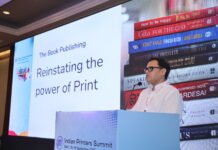“I am neither against Ethylene Vinyl Acetaten (EVA) nor sewing, but I personally feel that Polyurethane Reactive (PUR) binding has its own place in book binding, especially in publishing,” says Subhasis Ganguly, publishing veteran and consultant – publishing operations. But why shift to PUR when all these years people were happy with sewing or hot-melt binding? Ganguly is quick to state, “This is not sudden; the development has been going on for the last couple of years. Some printers and publishers have already tried PUR.”
That we can vouch for since Repro India, Thomson Press, Burda and Manipal Press have all invested in very high-end equipment for PUR binding. Most of the leading educational publishers are now trying or have already tried out and seen the benefits.
What is more useful – PUR or EVA?
It is true that if you pick up a PUR bound book and compare it to one bound by the EVA, you may not be able to see much visual difference, if any. If we do a case study, it can be seen that the main bottleneck in book binding is the sewing process. To mitigate this bottleneck, some publishers are opting for side stapling, which causes the book to not open properly and eventually causing a lot of difficulty to children. On the other hand, some publishers go for EVA perfect binding. To a large extent, there is no problem with EVA perfect binding if bound properly. However, the challenge is the temperature. According to Ganguly, EVA is bound to crack at a temperature of around 60 plus degree as it cannot sustain that temperature. “If you put an EVA bound book inside your stationary car out in the summer—where the temperature easily reaches above 60 degree—EVA is bound to crack. So the question is whether the book one is binding in one December midnight in Delhi, where the temperature gets as close to zero degree, and delivering it to Chennai in May when the temperature rises to as high as 48 degree, will sustain the temperature because inside the car the temperature can easily touch 70 degree or so,” he explains.
Here steps in PUR. Because PUR can sustain high temperature— higher than 70 degree—it does not crack. Also, you do not have to sew the book and the book can lay flat. This is one of the biggest advantages of PUR, and more importantly it has a very high tear factor. Also the pull strength is much higher than EVA. “And of course, if quality, quality and nothing less than quality are what you desire, PUR binding is for you,” Ganguly states.
we can take some break while the machine gets ready for the next job,” laments Ganguly. “Two things are very important these days—workflow and standardization. If your workflow is right, your process is standardized and checks are in place, the end product will come out good.”
“When the pressure is coming hard on your cost, how are you going to handle the situation? How can you save some money so that you can pass on that to the publishers without any dip in your margin?” asks Ganguly. “There are two ways—increase your efficiency, reduce your wastage. Waste management is a big thing. If your workflow is correct, if your checks are in place, your wastage is bound to reduce significantly.”

















